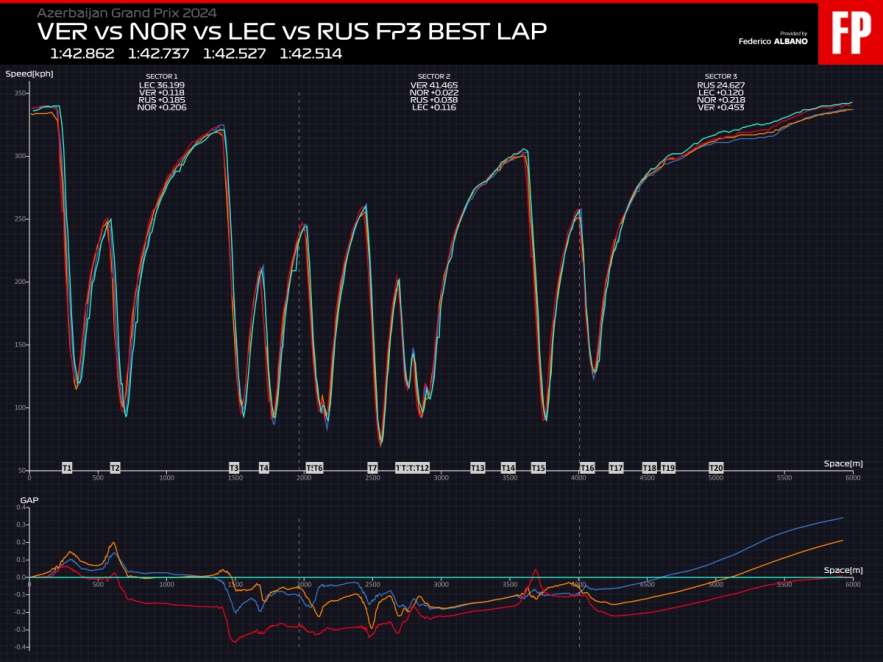Telemetry data
The third free practice session of the Azerbaijan Grand Prix certainly did not provide a clear favourite for pole position ahead of qualifying, but it did provide some technical insights and, above all, it showed some of the strengths and weaknesses of the various teams, although overall they often cancel each other out, resulting in the absolute balance we are witnessing so far this weekend.
Ferrari and McLaren good in traction
In this session, the map relating to the dominance on the track between the top four teams already explains many aspects of what was observed on the track. First of all, we note that Ferrari and McLaren tend to share the best 90-degree cornering and especially the traction on exit, confirming two very rewarding rear set-ups.
Norris then does a great job entering Turn 16, but it is Leclerc who has a “slingshot” exit on that corner, which “launches” the drivers into the very long main straight. The aggressive exit of Turn 16 is a “trademark” for Leclerc, as we see this particular fact every year now, and it is a significant help to the performance on the following, very long straight to the finish line.
From the graph we also see that RedBull is the best of the whole lot in braking, a sign of a probable attempt to shift the balance a bit towards the front to counteract the understeer reported yesterday during the first two sessions. Instead, it is Mercedes that excels in all the accelerations, so not necessarily in traction, but rather in terms of maximum speed. If we look at the indices relating to aerodynamic load we discover that Mercedes is in fact the one that numerically appears to be the most unloaded, with RedBull and Ferrari with a similar level of load and McLaren which, as usual, expresses the greatest downforce among the top teams.

Verstappen the best at the citadel, Leclerc good in the first corners
If we then look at the graph of the total lap, also observing the gap line carefully, we find other interesting ideas. For example, in the citadel section the best is undoubtedly Max Verstappen, who shows a good mechanical set-up of the car, able to respond adequately to the sudden inputs given by the driver in that section, with a rigidity, which we know is innate in the Milton Keynes single-seater, which evidently in this case is an aid in managing such a complicated section of track. McLaren also shows its best performance in the central sector of the track, although Norris is the best in the section immediately before the citadel, that is, that of turns 5, 6 and 7. Leclerc instead finds an excellent performance in turns 2 and 3 and opens an initial gap with his opponents. Ferrari appears fast on the straight, above all thanks to a good traction phase. In general, Red Bull and Ferrari seem to be similar in some characteristics such as the general level of downforce and aerodynamic efficiency, an aspect that the new package of the Maranello team seems to have implemented well. We then notice in the very long final straight how Mercedes is in fact very fast in extension, with a more unloaded set-up as the numbers show, particularly rewarding from the point of view of maximum speed. In the final part of the speed graph we then note the step relative to the opening of the DRS, and it is quite evident that Ferrari and Red Bull have a similar trend (also confirming a similar level of load at the rear) and superior to the others. The impression is that Mercedes is less effective as it is already more unloaded, while McLaren as it has the least efficiency of the lot in terms of gain with the opening of the mobile wing. Qualifying remains a huge unknown in this situation. The four cars actually seem all very close and all capable of obtaining the pole. Every slipstream, every curve, every detail can make the difference between a pole position and a fourth row.
#FP3 #telemetry #Ferrari #pole #Baku #McLaren #Red #Bull #Mercedes